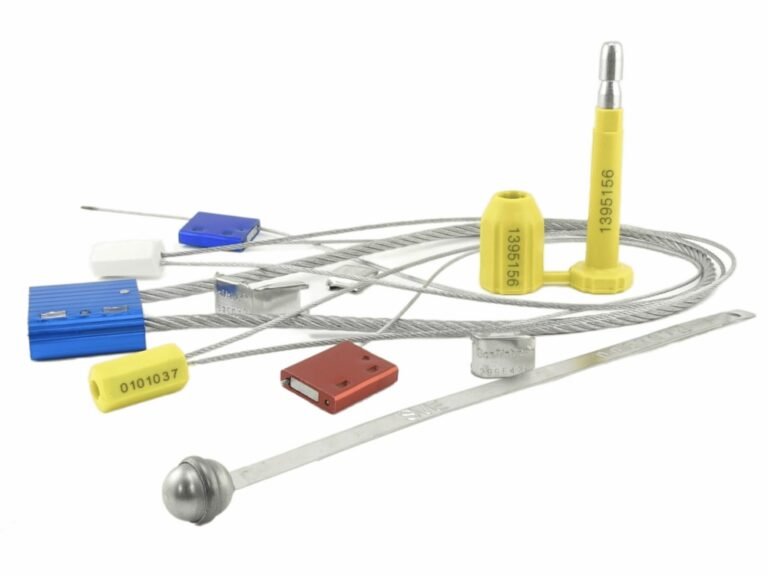Choosing the wrong seal for your truck can lead to cargo theft, customs fines, and catastrophic compliance failures. This isn't just about picking plastic or steel; it's a critical business decision.
To choose the right security seal, analyze your shipment's entire journey. For high-risk, cross-border routes requiring C-TPAT compliance, a high-security bolt seal is essential. For versatile needs, use a cable seal. For low-risk, domestic trips where tamper-evidence is key, a plastic seal is most cost-effective.
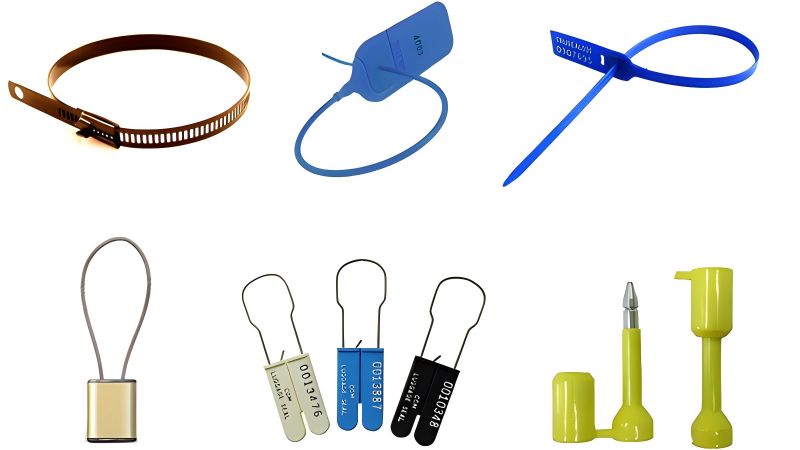
Early in my career, clients would ask me to recommend a seal based on their cargo. "I'm shipping electronics, what should I use?" they'd ask. But my experience, especially from my days in quality control, taught me that this is the wrong question. I never choose a seal based on the cargo alone; I choose it based on the route and the process. The journey is what defines the risk. Let's break down how to make this strategic decision for your business.
More Than Just Plastic and Steel: Key Factors in Your Seal Selection?
Do you pick your security seals based only on cargo value? This narrow approach overlooks the biggest risks in your supply chain, leaving you exposed to unexpected losses and delays.
The most critical factors for seal selection are the shipment's route risk (cross-border vs. local), compliance requirements (like C-TPAT), and the physical nature of the locking point. These elements, more than just the cargo's value, determine your true security needs.
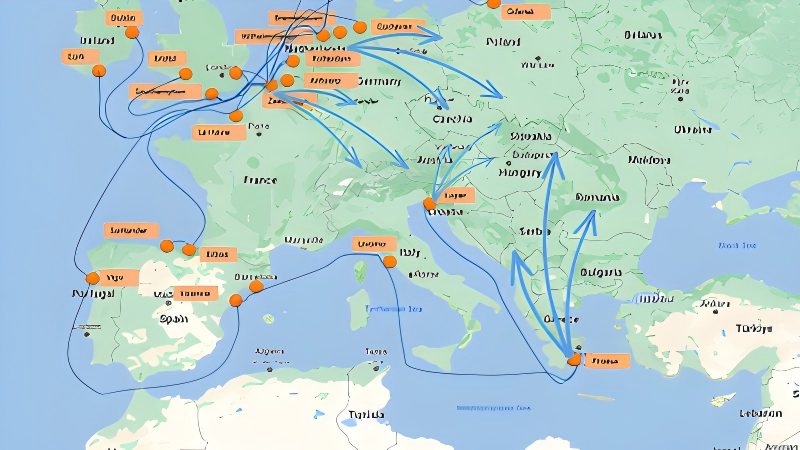
My approach is to categorize security into two types: barrier security and evidence-based security. For a high-risk journey—like a cross-border shipment moving through multiple checkpoints—you need a barrier. This is a seal designed to be a physical deterrent, like a high-security bolt seal. For a low-risk journey, like a local delivery between two of your own warehouses, your main goal is evidence. You just need to know if the truck was opened. An indicative plastic seal does that perfectly and cost-effectively. Thinking in terms of "barrier" vs. "evidence" simplifies the selection process and aligns your spending with your actual risk level.
The Bolt Seal: Your Go-To for High-Security and Compliance?
Are your shipments crossing international borders? Using anything less than a high-security bolt seal for these routes is a direct path to customs rejection, heavy fines, and a compromised supply chain.
The bolt seal is the gold standard for high-security applications. It is specifically designed to meet ISO 17712 "H" class standards, making it the mandatory choice for programs like C-TPAT. It acts as a formidable physical barrier, protecting high-value goods on high-risk journeys.
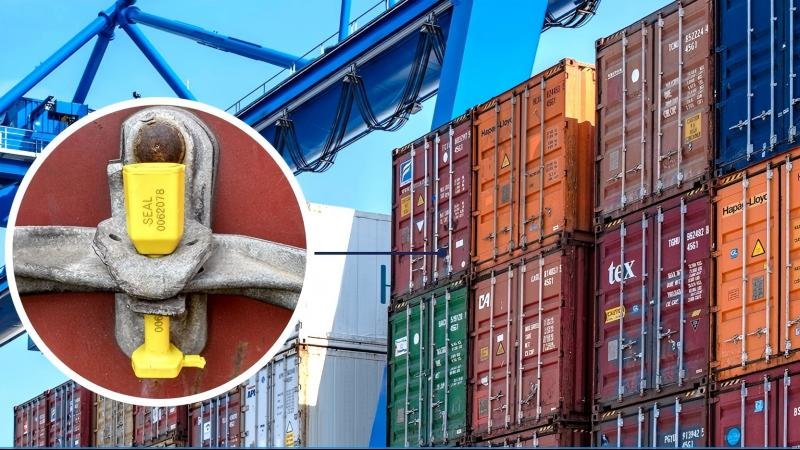
I always refer to the bolt seal as the "compliance seal." A pitfall I've helped many clients avoid is thinking that any strong-looking seal will do for international freight. A customs officer is trained to look for one thing: an ISO-certified, "H" class bolt seal. If they don't see one, that container is getting flagged for a secondary inspection 99% of the time. The bolt seal is made of a hardened steel pin and a locking barrel, often with anti-spin features to prevent tampering by friction attack. It's designed to be a one-time-use barrier that requires heavy bolt cutters for removal. It is the definitive choice when your cargo's security and compliance are non-negotiable.
The Cable Seal: Unmatched Versatility for Irregular Cargo and Equipment?
What do you do when a truck's locking mechanism won't fit a standard bolt seal? Forcing the wrong seal can damage equipment or, worse, leave your cargo effectively unsecured during transit.
The cable seal offers the perfect blend of high security and flexibility. Its adjustable steel cable can secure a wide variety of locking points that bolt seals cannot, such as tankers, valves, and warehouse roll-cages, while still providing a strong physical barrier.
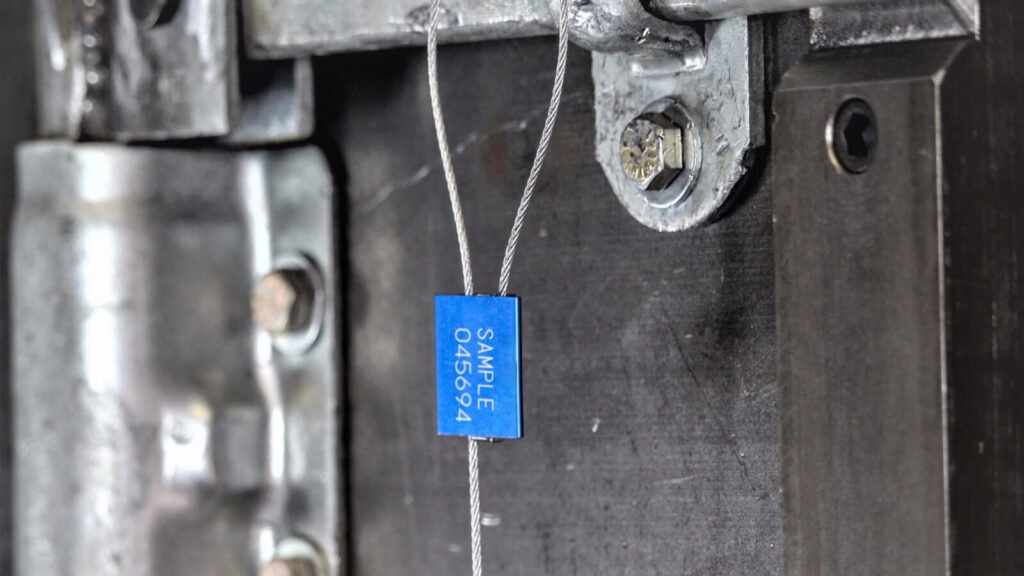
I call the cable seal the "problem-solver." I once had a client transporting bulk liquid chemicals in tankers. They were trying to secure the valves with bolt seals, which was impossible due to the valve design. Their cargo was high-value and the route was high-risk, so a plastic seal was out of the question. The solution was a high-security cable seal. We used a 3.5mm diameter steel cable seal that offered a level of barrier security comparable to a bolt seal but with the flexibility to fit the irregular locking point perfectly. This is a classic example of how the physical constraints of the journey—in this case, the equipment itself—dictate the choice of seal.
The Plastic Seal: Cost-Effective Security for Tamper Evidence?
Are you spending too much on high-security seals for low-risk, local deliveries? Over-securing your cargo is an unnecessary expense that eats directly into your profit margins without adding real value.
The plastic seal is the most cost-effective solution for tamper evidence. It is an indicative seal, meaning its primary job is not to be a barrier, but to clearly show if a lock has been opened. It is ideal for low-risk, domestic routes where process control is the main goal.
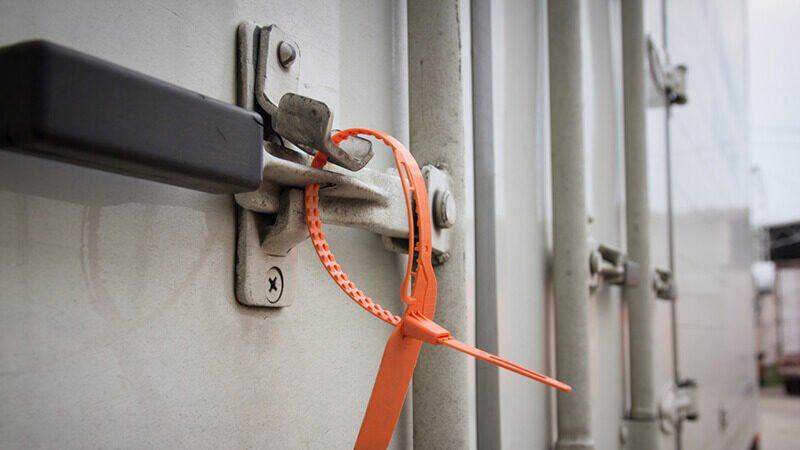
In my experience, plastic seals are the workhorses of domestic logistics. Think about a truck moving tote boxes of supplies between a central warehouse and local retail stores. The risk of organized crime hijacking the truck is low. The main concern is preventing opportunistic theft or ensuring drivers follow protocol. A simple, uniquely numbered pull-tight plastic seal is perfect. It's cheap, easy to apply, and if it's broken, you know immediately that the chain of custody was breached. Using a $1.50 bolt seal here when a $0.20 plastic seal does the job is a common pitfall that I help clients correct to optimize their security budget.
Decision Matrix: A Quick Chart to Match Your Journey to the Perfect Seal?
Feeling overwhelmed by the options? Making the right choice doesn't have to be complicated. This simple matrix can help you select the most appropriate and cost-effective seal every single time.
This decision matrix guides you based on the three most critical factors: transport risk, compliance requirements, and the value of your cargo. It provides a clear recommendation that aligns your security measures directly with your needs.
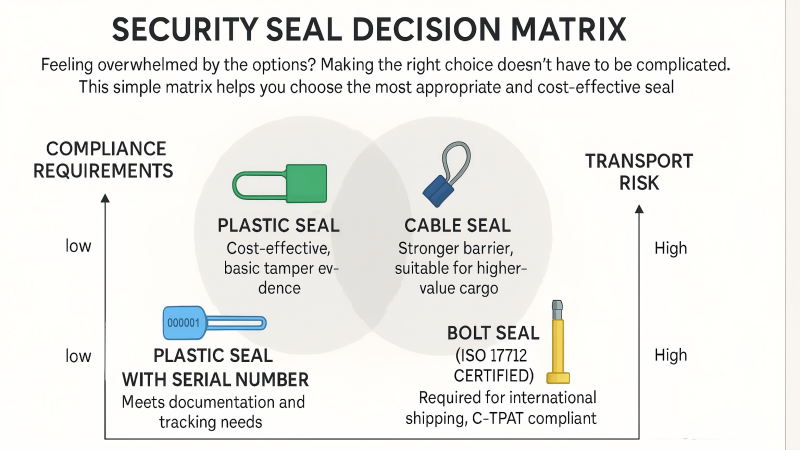
This is the exact framework I use when advising my clients. It moves beyond just "what are you shipping?" to a more strategic analysis of the entire journey. By considering all the variables, you ensure you are never over-spending on security you don't need, or worse, under-protecting a shipment that is highly vulnerable. This simple chart helps you make a professional, data-driven decision, not just a guess.
| Shipment Scenario | Key Factors | Recommended Seal Type |
|---|---|---|
| High-Value Electronics | Route: Cross-border (High Risk) Compliance: C-TPAT Mandatory Locking: Standard Container Doors | Bolt Seal (High Security) |
| Bulk Liquid Chemicals | Route: Domestic Long-Haul (High Risk) Compliance: None Locking: Irregular Tanker Valves | Cable Seal (High Security) |
| Retail Apparel | Route: Local Distribution (Low Risk) Compliance: None Locking: Truck Doors / Tote Boxes | Plastic Seal (Indicative) |
| Pharmaceuticals | Route: Cross-border (High Risk) Compliance: C-TPAT Mandatory Locking: Temp-Controlled Trailer | Bolt Seal (High Security) |
Conclusion
Choosing the right seal is a strategic decision. Base your choice not on the cargo alone, but on the entire journey's risk, compliance needs, and physical requirements to ensure optimal, cost-effective security.
Get a Strategic Seal Recommendation from ProtegoSeal
To ensure you're using the most effective security seal for your specific routes and risks, ProtegoSeal offers more than just products; we offer strategic analysis. We help you align your security measures with your actual needs, lowering your risk and preventing unnecessary costs. Contact me for a personalized consultation or to request samples.

